The resplendent Harlequin was developed by Leslie Bonnet of Wales from a color mutation that showed up in his Khaki Campbells in 1949. Our original stock was out of birds imported directly from the originator, Mr. Bonnet. We have been diligently selecting our Harlequins since 1982 to maintain a high degree of authenticity.
If you want a brilliantly colored duck that lays like a Campbell, is a tremendous forager, weighs 5 to 5 1/2 pounds, then the Harlequin is an excellent choice. Annual egg production in our flocks has been averaging 260 to 350 white eggs per female. If allowed to set, many Harlequin females will successfully hatch ducklings.
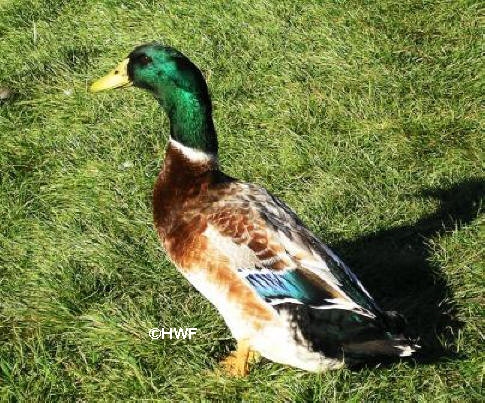
Two-Year-Old Silver Welsh Harlequin Drake
An excellent Harlequin drake with the desired length of body, size (5 pounds). and coloring & markings.
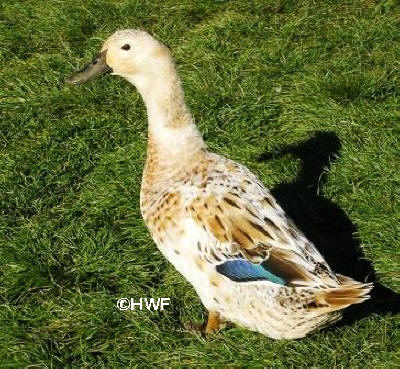
Two-Year-Old Silver Welsh Harlequin Duck
This picture was taken in October when she was in full nuptial plumage. Dave Holderread, who wrote the American Poultry Association Standard for the Welsh Harlequin, says that this female has ideal color for a mature Silver Harlequin duck. (In photos, the fawn shading in Harlequin female plumage frequently appears paler than in real life--so keep in mind when viewing this photograph that this bird has more fawn shading than is apparent here.) First year Harlequin females typically have lighter colored plumage than when they are mature. Also, females go through several color changes through the course of a year. The Standard color description is for the fall nuptial plumage.
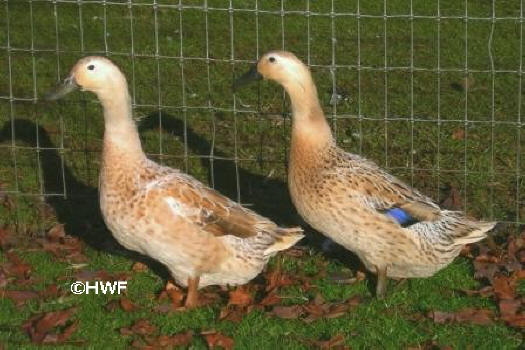
A 4-year-old Golden Harlequin female (left), A Yearling Silver Harlequin female (right). This Silver female has ideal conformation and type. The Golden female has become a bit less stream-lined and smooth bodied with age. The distinct wing speculum color of the two varieties is clearly visible in this photograph: the Goldens have bronze or greenish-bronze speculum, the Silvers have brilliant blue speculums. Both varieties should have blackish-green bills as shown here.
Welsh Harlequins come in two color phases. The Harlequins originator, Leslie Bonnet of Wales, created both varieties but we can find no evidence that he made a distinction between the two colors. Here at The HWF & Preservation Center we have named the two varieties, the Golden and the Silver. The Golden was the original color that Mr. Bonnet described in his book, Practical Duck-keeping, published in 1960. In 1968, when Mr. Bonnet sent hatching eggs to the United States, most of the hatchlings were of the Silver phase. We have been careful to preserve high quality strains in both varieties.
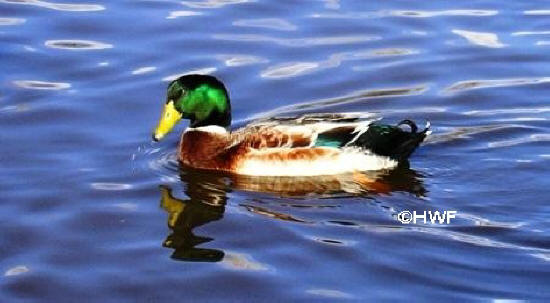
6-Month-Old Silver Welsh Harlequin Drake Enjoying a Swim on One of Our Ponds
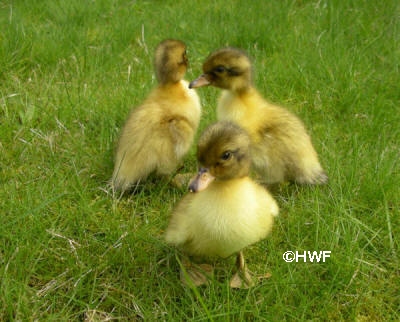
Day-Old Silver Welsh Harlequin Ducklings
(Notice the egg-tooth at the tip of the front duckling.)
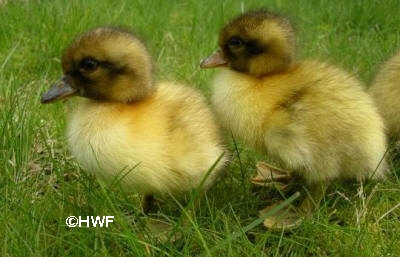
A Pair of Silver Welsh Harlequin Day-Old Ducklings
Although not always as distinct as it is in this pair, day-old Harlequin males often have darker bills (left duckling) than the females (right duckling). The bill color difference usually last only 2 or 3 days after hatching.
Copyright 2009 Holderread Waterfowl Farm & Preservation Center